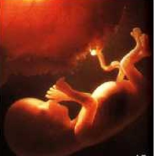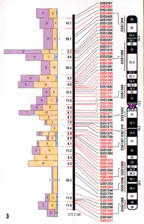 This is a quasi-review of Practices of Looking, by Marita Sturken and Lisa Cartwright. Instead of reviewing the entire book, I’m just going to provide my take on one chapter. This should give prospective readers/instructors/haters a better idea of what to expect from this somewhat aged text.
This is a quasi-review of Practices of Looking, by Marita Sturken and Lisa Cartwright. Instead of reviewing the entire book, I’m just going to provide my take on one chapter. This should give prospective readers/instructors/haters a better idea of what to expect from this somewhat aged text.
In the chapter titled, “Scientific Looking, Looking at Science,” the authors discuss the give-and-take relationship of visual culture and science, stating that “knowledge itself changes with [the] shift in the mediation of knowledge [from verbal to visual.]” Beginning by outlining the early history and effects of photography and x-ray in science and biomedicine, the authors continue to modern times and the influence of sonograms and digital imaging on how human’s perceive themselves.
Positivism: the early history of science & visual culture
With the introduction of photography and x-ray into science in the early 19th century, the faith the public placed in the objectivity of the photographic image directly influenced their faith in new scientific and pseudo-scientific theories and perspectives. People believe in “photographic truth” yet “photographic images are highly subjective cultural and social artifacts that are influenced by the range of human belief, bias, and expressions.”
 In the early 1800s, various political and scientific groups began cataloging the physical characteristics of numerous human subjects, which lead to the pseudosciences of craniology and phrenology—holding that one could deduce a person’s mental and spiritual aptitude by their physiognomy. John Beddoe, in The Races of Man, posited an “Index of Nigressence” that listed Britains at the top of human development and “Africanoids,” such as the Irish, at the bottom. These lines of thought soon lead to the study and practice of eugenics.
In the early 1800s, various political and scientific groups began cataloging the physical characteristics of numerous human subjects, which lead to the pseudosciences of craniology and phrenology—holding that one could deduce a person’s mental and spiritual aptitude by their physiognomy. John Beddoe, in The Races of Man, posited an “Index of Nigressence” that listed Britains at the top of human development and “Africanoids,” such as the Irish, at the bottom. These lines of thought soon lead to the study and practice of eugenics.
Cinema & the objective
Direct Cinema emerged in the 1960s as a realistic, documentary style of film-making that utilized no-frills, grainy film-stock (similar to that of modern security cameras) coupled with long takes to emphasize the authenticity of the images presented. Similar film has since been used in many court cases including that of Rodney King. The idea is that a photograph does not lie; but, again, people can interpret and manipulate images in many different ways. For example, the Rodney King footage was used by both the defense and the prosecution to promote their oppositional views of the scene in question. Many reality-TV shows evidence the subjective and often manipulative way in which situations can be filmed and edited to present a narrative incongruous with the original events.
Sonograms & fetal personhood
If film can (mis)represent objective reality, then what reality do fetal sonograms present? “In the case of the fetal sonogram the biomedical image takes on the aura of a portrait, a document of the fetus’s status as a social being,” This image of the fetus then takes on a social, religious and political role, however unintended, as it enters the controversy of abortion. In ex-abortionist Dr. Bernard Nathanson’s 1984 documentary The Silent Scream, prolife arguments are voiced over an ultrasound of a fetus and an abortion that supposedl y show the fetus reacting to pain stimuli. Slavo Zizek argues, in Enjoy Your Symptom!, that women who use a sonogram as a first-image of their child are not necessarily buying into the concept of fetal personhood but “are appropriating medical culture’s artifacts to construct cultural narratives inflected by other aspects of their worlds.” Inspired by Nathanson, photographer Lehnart Nilson published the book A Child is Born composed of images of fetuses as they developed through the stages of gestation. Some feminists have since argued that such images (of the fetus without the mother) have aided in promoting a visual culture wherein the significance of women in the process of birth as well as the political debate surrounding it is greatly diminished and that this has fed a view of the fetus’s interests as independent of and oppositional to that of the mother.
y show the fetus reacting to pain stimuli. Slavo Zizek argues, in Enjoy Your Symptom!, that women who use a sonogram as a first-image of their child are not necessarily buying into the concept of fetal personhood but “are appropriating medical culture’s artifacts to construct cultural narratives inflected by other aspects of their worlds.” Inspired by Nathanson, photographer Lehnart Nilson published the book A Child is Born composed of images of fetuses as they developed through the stages of gestation. Some feminists have since argued that such images (of the fetus without the mother) have aided in promoting a visual culture wherein the significance of women in the process of birth as well as the political debate surrounding it is greatly diminished and that this has fed a view of the fetus’s interests as independent of and oppositional to that of the mother.
The digital body

Images of the interior structure of the human body have shifted from analogue to digital. As a result, people have naturally begun to identify with a more computerized vision of humanity. This is evidenced by the impact of books like Cyberia, movies such as The Matrix and Blade Runner, and television shows like Reboot. Out of all scientific endeavors, the Human Genome Project has probably most influenced a digital view of humanity.

The Human Genome Project presents a humanity bereft of the centuries-old ghost-in-a-machine duality and consisting simply of strand after strand of genetic code. Skeptics object that a new racial and general stratification based on specific genetic-coding differences will simply replace the old racism and rigid characterizations of the pseudo-sciences of physiognomy. Religious and philosophical objectors argue that Human Genome Project metaphors such as “mapping code” and “blueprinting” are unsettlingly accurate depictions of this dehumanizing approach to the basic consistency of humanity.
First invading our bones with x-ray imaging and then our births with ultrasound and now our very genetic structure with digital imaging, science has long challenged us to reevaluate our own facile self-image through its own lenses. Informing our political debates and catalyzing social upheaval, the influence of science on visual culture, and vice versa, is as undeniable as it is recondite. As we plod relentlessly into a future increasingly informed by a mercurial visual culture, there is no telling what previously intangible and inviolate aspect of our being will next be touched and informed by the eyes of science.